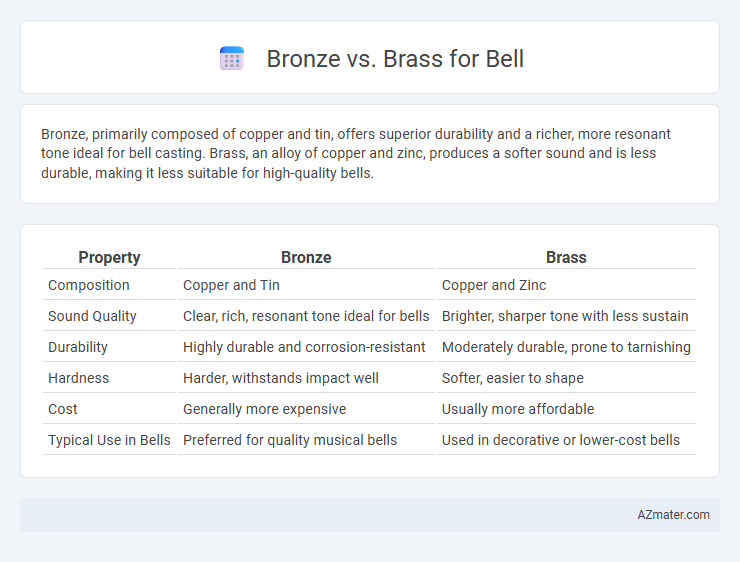Bronze, primarily composed of copper and tin, offers superior durability and a richer, more resonant tone ideal for bell casting. Brass, an alloy of copper and zinc, produces a softer sound and is less durable, making it less suitable for high-quality bells.
Table of Comparison
| Property | Bronze | Brass |
|---|---|---|
| Composition | Copper and Tin | Copper and Zinc |
| Sound Quality | Clear, rich, resonant tone ideal for bells | Brighter, sharper tone with less sustain |
| Durability | Highly durable and corrosion-resistant | Moderately durable, prone to tarnishing |
| Hardness | Harder, withstands impact well | Softer, easier to shape |
| Cost | Generally more expensive | Usually more affordable |
| Typical Use in Bells | Preferred for quality musical bells | Used in decorative or lower-cost bells |
Introduction to Bell Materials
Bronze and brass are the primary materials used in bell manufacturing due to their distinct acoustic properties and durability. Bronze, typically an alloy of copper and tin, produces a rich, resonant tone with excellent sustain, making it the preferred choice for traditional bells and church towers. Brass, predominantly copper and zinc, offers a brighter sound with less sustain and is often used for smaller, decorative bells or in cost-sensitive applications.
Understanding Bronze: Composition and Properties
Bronze, primarily composed of copper and tin, is favored for bell making due to its superior acoustic properties and durability. The typical bronze alloy for bells contains around 78% copper and 22% tin, offering excellent resonance and a bright, clear tone. Its hardness and resistance to corrosion contribute to the bell's longevity and consistent sound quality over time.
Brass Explained: Composition and Properties
Brass, an alloy primarily composed of copper and zinc, offers excellent malleability and corrosion resistance, making it suitable for bells requiring bright, resonant tones. The zinc content varies, typically between 5% and 40%, influencing its strength and acoustic properties. Compared to bronze, brass produces a softer sound with a warm, mellow timbre, preferred in certain musical and decorative bell applications.
Sound Quality: Bronze vs Brass Bells
Bronze bells produce a rich, resonant tone with superior sustain and clarity, making them the preferred choice for high-quality bell sound. Brass bells, while more affordable and easier to cast, yield a brighter but less complex sound that can lack the depth found in bronze. The metallurgical composition of bronze, typically a copper-tin alloy, enhances acoustic properties by improving vibration transmission and tonal richness compared to the copper-zinc composition of brass.
Durability and Longevity of Bronze vs Brass
Bronze bells exhibit superior durability compared to brass due to their higher resistance to corrosion and metal fatigue, ensuring consistent sound quality over extended periods. The copper-tin alloy in bronze forms a harder, more resilient structure that withstands environmental stress better than brass's copper-zinc composition. This enhanced longevity makes bronze the preferred material for bells intended for long-term use and outdoor exposure.
Cost Comparison: Bronze Bells vs Brass Bells
Bronze bells typically cost more than brass bells due to the higher copper and tin content, which enhances their durability and tonal quality. Brass bells, made primarily from copper and zinc, offer a more affordable option but may have a shorter lifespan and different acoustic properties. Cost differences reflect these material compositions, making bronze bells a premium choice for superior sound and longevity.
Historical Use of Bronze and Brass in Bell Making
Bronze has been the preferred material for bell making since ancient times due to its superior acoustic properties and durability, with early civilizations such as the Chinese and Europeans using bell bronze--an alloy typically consisting of approximately 78% copper and 22% tin--to achieve rich, resonant tones. Brass, composed mainly of copper and zinc, emerged later in bell production but generally produces a brighter, less resonant sound and is more prone to corrosion compared to bronze. Historic cathedrals and clock towers predominantly feature bronze bells, which maintain tonal clarity and longevity, reinforcing bronze's status as the traditional and favored alloy in the craft of bell founding.
Maintenance and Care for Bronze and Brass Bells
Bronze bells require periodic cleaning with a mild soap and water solution to prevent oxidation while avoiding abrasive materials that can damage the patina. Brass bells need regular polishing with a brass-specific cleaner to maintain their shine and prevent tarnish, especially in humid environments. Both metals benefit from protective coatings or wax treatments to reduce maintenance frequency and preserve acoustic quality.
Aesthetic Differences Between Bronze and Brass Bells
Bronze bells typically exhibit a deeper, richer tone and a darker, more muted color with a characteristic patina that develops over time, enhancing their traditional appearance. Brass bells display a brighter, more golden hue with a shiny, reflective surface that maintains a polished aesthetic for longer periods. The aesthetic appeal of bronze lies in its historical authenticity and aged elegance, while brass offers a contemporary, vibrant look favored in decorative settings.
Choosing the Right Material: Which is Better for Bells?
Bronze is preferred for bells due to its superior acoustic properties, durability, and ability to produce a clear, resonant tone with rich harmonics. Brass, while more affordable and easier to cast, tends to yield a softer, less vibrant sound with quicker tonal decay. Choosing bronze ensures longevity and a classic bell sound, making it the ideal material for high-quality bells.

Infographic: Bronze vs Brass for Bell
 azmater.com
azmater.com